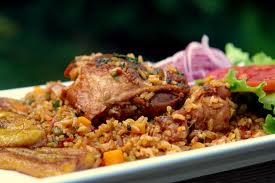Barbacoa is a form of cooking meat that originated in the Caribbean with the Taíno people, from which the term "barbecue" derives. In contemporary Mexico it generally refers to meats or a whole sheep slow-cooked over an open fire, or more traditionally, in a hole dug in the ground covered with maguey leaves, although the interpretation is loose, and in the present day and in some cases may refer to meat steamed until tender.
Barbacoa de cabeza is a specialty of slow cooked cow head that arose in the ranching lands of northern Mexico after the Spanish conquest. Except for cochinita pibil, one of the common characteristics of Mexican barbacoa is that marinades are not used and sauces are not applied until the meat is fully cooked (for examples of Mexican marinades, see carne de chango and carne al pastor). Pork cooked in this manner is generally referred to as carnitas rather than barbacoa.
Throughout Mexico, from pre-Mexican times to the present, barbacoa (the name derives from the Caribbean indigenous Taino barabicu) was the original Mexican barbecue, utilizing the many and varied moles (from Nahuatl molli) and salsa de molcajete, which were the first barbecue sauces. Game, turkey, and fish along with beans and other side dishes were slow cooked together in a pit for many hours. Following the introduction of cattle, domestic pigs, goats, sheep, and chickens by the Spanish, the meat of these animals was cooked utilizing the traditional indigenous barbacoa style of cooking.
"Barbacoa" actually has its origins in all the countries that Tainos and other Indian populations inhabited, not just Mexico. The Tainos themselves were pre-Columbian Indians located throughout the Caribbean and which some believe included the Arawak Indians who especially dominated the most leeward Caribbean islands themselves.
The Arawak were first and foremost those who historically used the green and fire resistant flexible limbs of the hanging branches of the giant Bearded Fig Tree (Los Barbadoes) to cook meats and fish over an open fire while first marinating their foods in tropical herbs and spices found naturally throughout the southern islands to South America. Unlike latter variations, the original and most authentic "Barbacoa" used herbs and spices, such as island prepared "cassareep" (derived from the root of the cassava plant), not only to enhance the natural flavors of meats, fish and vegetables, but preserve their cooked foods from spoiling in the heat of the tropics. The Arawak Indians called their preparations "Barbacoa," accordingly, as these methods proved to be a boon of protection for keeping their foods from prematurely spoiling.
A traditional Mexican way of eating barbacoa is having it served on a warm soft taco style corn tortilla with guacamole and salsa for added flavor; the meat or the tacos are often served in the banana leaves they were cooked in. It is also eaten with onions, diced cilantro and a squirt of lime juice.
 |
| Barbacoa |
Ingredients
- 3 Tablespoons vegetable oil
- 2 pounds mutton suitable for stewing
- 1 large diced yellow onion
- 8 cloves minced garlic
- 1 Tablespoon cumin
- 1 1/2 Tablespoon oregano
- 20 whole cloves
- 4 chipotle peppers with adobo sauce
- 1 cup chicken stock
- 1 cup water
- 2 bay leaves
- 2 Tablespoons white vinegar
Method
- Dry the mutton with a paper towel. This step is really important to get a nice crust on the mutton. Generously salt and pepper the mutton. Brown the mutton in a few Tablespoons oil in batches if you don’t have room in your pan. Take the mutton out and add the onions. Add more oil if you need it.
- Season the onions with some kosher salt and pepper. Cook until soft, about 8 minutes. Add in the garlic, cook for a few seconds. Add the cumin, oregano, chipotle, and cloves to the pan. Cook while stirring for a minute.
- Add the mutton, chicken stock, water, and bay leaves to the pan.
- Season with salt and pepper. Bring the mixture to a boil. Reduce the heat and cover with a lid. Put the mutton in a 325 degree oven for approximately 2 hours or until the mutton is fork tender. You could also keep this on the stove and simmer it until tender.
- After cook for some time test to make sure that the mutton is tender enough to shred with a fork. If it is not shredding easily, put it back in the oven for a bit longer. When it is ready to come out of the oven, take out the chipotle pepper.Add the white vinegar. Check for seasoning.
- After done serve the barbacoa.

 RSS Feed
RSS Feed Twitter
Twitter





 5:42 PM
5:42 PM
 Kalgyan
Kalgyan



























